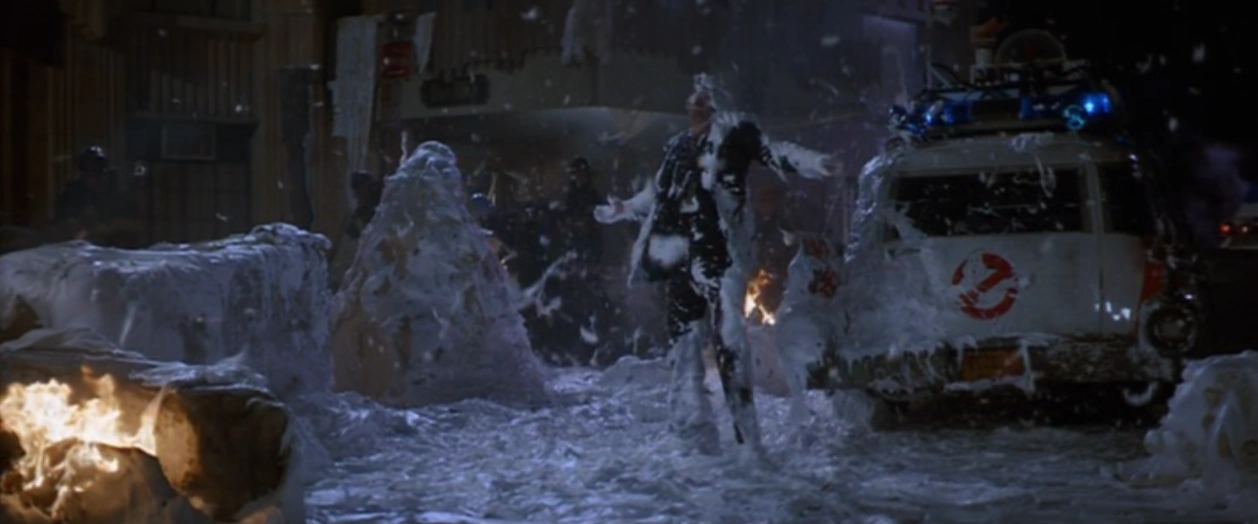The movie Ghostbusters epitomizes three central features of Reagan era America: greed, the benefits of trickle-down economics, and disdain for government regulation. The film begins with our three intrepid scientists, Ray Stantz (Dan Aykroyd), Egon Spengler (Harold Ramis), and Peter Venkman (Bill Murray) being kicked out of a prestigious university for failing to produce any meaningful research. The dean informs Venkman that “Your theories are the worst kind of popular tripe, your methods are sloppy, and your conclusions are highly questionable. You are a poor scientist, Dr. Venkman!” Dr. Venkman, however, is the perfect 1980s businessman.
With their university grant gone, the three "scientists" decide to establish “the indispensable defense science of the next decade; professional paranormal investigations and eliminations.” In order to do so, Stantz agrees to take out a third mortgage on his house at 19% interest. Venkman eases his conscience by pointing out “everyone has three mortgages nowadays.” Spengler notes that his interest rate payments in the first five years will total $95,000. Here is our first example of the excesses of the Reagan years. The bank hands out a predatory loan to three men who should have never received one in the first place. But if they fail to pay, then the bank will recoup its money by seizing Ray's house.
Next the Ghostbusters purchase a dilapidated firehouse for their headquarters. Ever the voice of wisdom, Spengler details how the building has, “serious metal fatigue in all the load-bearing members, the wiring is substandard, it's completely inadequate for our power needs, and the neighborhood is like a demilitarized zone.” Stantz, meanwhile, is impressed by the fire pole and demands they buy the place immediately. Here, the force of greed at work is the real estate agent, sensing the Ghostbusters’ desperate need for a place of business. She seizes the opportunity to unload an undesirable property. By the time, the Ghostbusters business fails, she’ll have collected her fees and someone else will have to deal with the fallout.
Once they open their doors, the Ghostbusters become as predatory and greedy as the bank and real estate agent. They charge the manager of the Sedgwick Hotel five thousand dollars for trapping and storing the establishment’s pesky poltergeist. This price does not include the thousands of dollars of damage the Ghostbusters caused to the 12th floor of the hotel and the main ballroom (not to mention the loss of the future business of Mrs. Van Hoffman whose event was ruined by their actions). As their fame soars, the Ghostbusters dart around Manhattan battling supernatural forces and dancing the night away in famous clubs. They grace the covers of magazines, appear on television, and become celebrities in their own right. The exploited have become the exploiters.
As the Ghostbusters fame and workload grow, we see trickle-down economics in action. They hire the film’s only African-American character, Winston Zeddmore (Ernie Hudson)—he’s also the first man to come through the door. When asked by the company secretary if he believes in the paranormal, Zeddmore replies, “Ah, if there's a steady paycheck in it, I'll believe anything you say.” As an African American seeking employment from an all-white firm in the 1980s, Zeddmore knows that if he wants the job, he needs to keep his mouth shut. The Ghostbusters are, according to the principles of Reaganomics, letting their success trickle down. They hire from the local community. Zeddmore, once unemployed, now has a job. He will soon have money in his pocket to inject back into the economy. As the Ghostbusters profit, so will he. As the company expands, they can hire more local residents. The resulting rising tide will lift everyone’s boat. Little did Winston know that he was proof of the genius of Reaganomics.
Ghostbusters also highlights the Reagan administration’s hatred of regulation. While Gozer the Gozerian is the film’s ostensible film, Walter Peck of the Environmental Protection Agency is a close second. Peck arrives at the Ghostbusters headquarters and asks to view the containment facility for the ghosts. Since the Ghostbusters only trap the ghosts, Peck wants to see where they are held. Venkman denies him entry. Venkman, now a successful self-interested businessman and capitalist, recognizes that Peck represents a threat to the Ghostbusters’ growing and profitable business. So he throws Peck out.
Peck’s subsequent attempts to interfere in the Ghostbusters’ business offers further proof the dangers of regulation. When Peck expresses skepticism about the company’s methods and shuts off power to their storage facility, his actions have unintentionally disastrous consequences. Turning off the protection grid releases all the ghosts who then go and terrorize Manhattan. Peck then confronts the Ghostbusters in the office of the Mayor of New York. The Mayor, however, like any callous politician, acts in own self-interest. He believes that the Ghostbusters plan of fighting the impending arrival of Gozer the Gozerian will lead to his own re-election. Now that the Mayor has hired the fox to guard the henhouse, Peck is left to wander the streets of New York City. He witnesses the destructive rampage of a gigantic Stay Puft Marshmallow Man (conjured from the imagination of Ray Stantz). Peck suffers a final indignity for attempting regulate big business. After the destruction of the Stay Puft Marshmallow Man, through some dubious luck of crossing the streams and the door swinging both ways, Peck is buried in a cavalcade of marshmallow. The Ghostbusters, due to dumb luck and their own exploitative actions, receive all the credit for saving the city. Meanwhile the man who tried to protect the public, Walter Peck, receives nothing but scorn and derision.
So the next time you watch Ghostbusters don’t think of it as the classic comedy that you know and love, but rather as the paean to Reaganomics that it truly is.

_theatrical_poster.png)


No comments:
Post a Comment